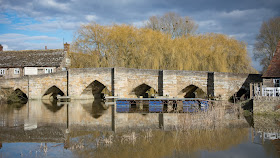The local options here are The Ridgeway and The Thames Path - I opted for the later.
My experiences of the bits of the Ridgeway are that it can get very, very muddy at this time of year (and to make things worse it can get very chewed up by vehicles), maybe I'll get back to that a bit later. Mind you the Thames Path can also get very muddy too, and it has the added attraction of flooding.
I've been exploring the Thames Path via a series of day walks from Oxford - so far I've done four days walking down stream (as far as Reading), and two days heading up stream (to Lechlade) - in each direction using either buses or trains to get to/from the path each day. I've done just over 70 miles of the official 184 miles.
From East to West: Reading to Pangbourne
Path from Caversham Lock, under the Reading bridges and out of town along the Thames Side Promenade, squeezes along the river bank below Tilehurst Station then from Marpledurham Lock along the tow path into Pangbourne.
 |
| Christchurch Bridge, Reading |
 |
| Marpledurham Lock |
Pangbourne to Wallingford
Across Whitchurch bridge, then uphill away from the river before dropping back into the lovely Hartslock Wood (walking high above the river). Then back to the riverside and as the Thames turns north and on to pass between Goring and Streatley (at this point the Thames Path is on the west back of the Thames and the Ridgeway on the East). The Thames Path snakes it's way through Moulsford and behind the school before passing the riverside boat houses on the run in towards Wallingford Bridge.
 |
| Goring Lock |
 |
| Sculling into Wallingford |
Wallingford to Abingdon
This bit of the path mostly sticks tight to the river bank (except through Shillingford) as it follows the meanders through Preson Crowmarsh, Shillingford and Little Wittenham, occasionally swapping from left back to right and back again. Swinging due west then back to the north again then finally east on the way up to Abingdon Bridge.
 |
| Wallingford Bridge |
 |
| Clifton Hampden Bridge |
Abingdon to Oxford
The river all seems more contained along this reach - passing house backs and the Radley boathouses on the way back into the numerous Oxford bridges.
 |
| Rose Isle |
 |
| Iffley Lock |
Oxford to Newbridge
The river sneaks it's way north through town - past the Head of the River and the train station before finding it's way out into the wide open spaces across Port Meadow up to Godstow Abbey. Then as alternative paths (Shakespeare's Way and the Oxford Canal Walk) continue North, the Thames and it's path make a decisive turn to the west - via Swinford Bridge and meandering (via some distinctly flood-ready reaches, requiring minor detours) through to Newbridge.
 |
| Across Port Meadow |
 |
| Newbridge |
Newbridge to Lechlade
The Thames gets significantly narrower as it it works it way through to Lechlade, and in places very flooded (at this time of year) - finding alternative routes is now part of the navigational challenge. And we get to go past the final sets of the locks on the river finishing with St John's Lock just outside Lechlade - these locks are now home to Father Thames himself (he used to sit closer to the source about another 25 miles west.
 |
| Alternative Routes Needed |
 |
| Boats at Radcot |
 |
| Father Thames |
Logistics
All these chunks of the Thames Path are readily doable using local buses and trains. Downstream from Oxford the start/end points are serviced by frequent buses (except Pangbourne, where the train is easier). Upstream from Oxford (at Newbridge and Lechlade) the buses are rather less regular - and it helps to know the timetable and to keep an eye on the time as you get to the end of a walk!




































